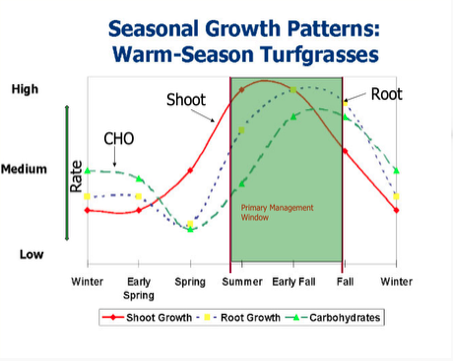Why Fall Fertilization Matters for Warm-Season Lawns

When it comes to building a resilient warm-season lawn, what you do in the fall sets the tone for next year’s success. While your Bermudagrass, Zoysiagrass, or St. Augustinegrass may still appear lush in early fall, the plant is already beginning its transition toward winter dormancy.
Let’s take a closer look at why fall fertilization matters — and how Canopy’s soil-first approach supports long-term turf health.
Fall Is the Root-Fortifying Season
Warm-season grasses thrive during the summer, when soil temperatures are high and both shoot and root growth peak. But as days shorten and temperatures decline in early fall, the plant’s energy shifts from top growth to root development and carbohydrate storage — a process essential for surviving winter and powering regrowth next spring.

In the chart above, you’ll notice that while shoot growth drops in fall, root growth remains moderate, and carbohydrate (CHO) levels start to rise. This is your lawn’s way of preparing for dormancy — and it’s the ideal time to feed the soil.
How Canopy Supports This Transition
We’ll continue applying beneficial liquid active carbon to your property in the early fall that does more than just “feed the grass.” Our proprietary liquid fertilizer contains oilseed extracts — a powerful source of active carbon — along with nutrients that support root strength, microbial health, and soil structure.
Why active carbon?
Active carbon is the fuel source that energizes your soil’s microbiome. Beneficial fungi, bacteria, and yeast feed on these organic inputs and unlock bound-up nutrients already present in your soil. That means better nutrient uptake and healthier roots — without overloading your lawn with synthetic inputs.
The Power of Carbohydrate Storage
Fall fertilization helps warm-season grasses store carbohydrates in their roots and crowns, giving them the energy needed to:
- Tolerate winter cold and stress
- Bounce back more quickly in spring
- Resist disease and drought
- Thrive with fewer synthetic inputs
This isn’t about pushing new top growth. It’s about strengthening what lies beneath — because that’s where next season’s success starts.
The Primary Management Window Closes Soon
As the chart shows, the window for meaningful soil activity and nutrient uptake begins to close as soil temperatures fall below 65°F. That’s why fall fertilization must be timed carefully.
In regions like Texas, Florida, and the Southeast, early to mid-fall is the sweet spot for applying soil-building nutrients — right before your warm-season turf goes fully dormant.
Fall Is a Time to Invest in Soil Health
At Canopy, we believe in feeding the soil, not just the grass. That means taking a proactive, regenerative approach that prioritizes:
- Microbial diversity
- Active carbon sources
- Low-salt, soil-safe nutrients
- Root-zone health and function
Fall fertilization isn’t a last hurrah for your lawn — it’s a smart investment in the year to come!
Get a Free Quote Today
If you’re ready to give your warm-season lawn the soil support it needs this fall, we’d love to help.
Contact us today for a free quote — and let’s build a better lawn, together.





